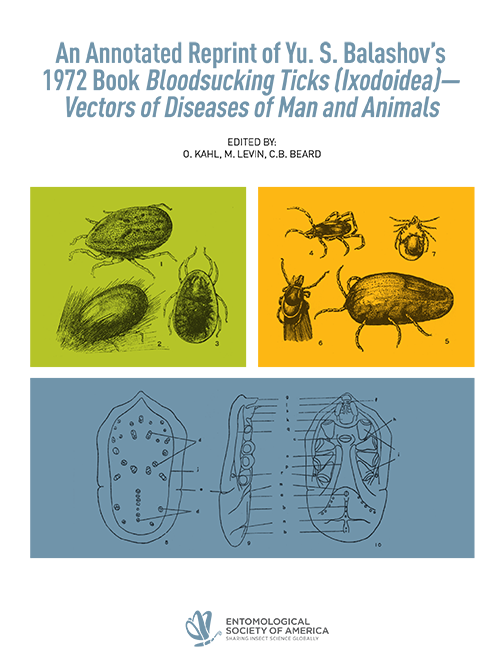Republication of Yuri Balashov's Bloodsucking Ticks features taxonomic updates, new references for today's generation of tick researchers
Annapolis, MD; April 20, 2023—At a time when tick-borne diseases are experiencing a global resurgence, the need to understand tick biology is perhaps greater than ever. And, for the researchers hard at work in that pursuit, a book first published in the Soviet Union more than 50 years ago remains one of the foundational resources illuminating what makes ticks such successful vectors of disease.
 Yuri Balashov's Bloodsucking Ticks (Ixodoidea)—Vectors of Diseases of Man and Animals is an enduring classic in the world of entomology and acarology (the study of ticks and mites). First published in 1967 in Balashov's native Russian, the book was translated and published in English in 1972 by the Entomological Society of America. In 2023, the English volume has been re-published anew, with detailed annotations that update the foundational text for today's generation of researchers.
Yuri Balashov's Bloodsucking Ticks (Ixodoidea)—Vectors of Diseases of Man and Animals is an enduring classic in the world of entomology and acarology (the study of ticks and mites). First published in 1967 in Balashov's native Russian, the book was translated and published in English in 1972 by the Entomological Society of America. In 2023, the English volume has been re-published anew, with detailed annotations that update the foundational text for today's generation of researchers.
"This classic monograph was published more than 50 years ago, but most of its contents are still highly informative and well worth reading, also for young tick researchers," says Olaf Kahl, Ph.D., tick biologist and co-founder of Tick Radar in Germany and co-editor of the new edition. "Extensive annotations in this reprint point out typos and erroneous translations in the first edition, and they also indicate wherever there is new knowledge available. Moreover, taxonomic changes over the past decades are dealt with so readers will not take up outdated knowledge. It is to be hoped that these additions will maximize the value of this book for readers, allowing the old opus to shine in new gloss without changing its original text."
Yuri Sergeevich Balashov, Ph.D. (1931 – 2012), was a world-renowned authority in acarology, general parasitology, and the relationship of arthropod vectors with their vertebrate hosts and agents of vector-borne diseases. He received his Ph.D. in 1957 from the Zoological Institute of the USSR Academy of Sciences in Saint Petersburg, Russia, and went on to author more than 200 scientific publications and monographs.
The new edition of Balashov's first-of-its-kind work is edited by Kahl along with Michael L. Levin, Ph.D., and C. Ben Beard, Ph.D., of the U.S. Centers for Disease Control and Prevention. Together, Kahl, Levin, and Beard provide 30 pages of annotations offering technical comments, taxonomic updates, improved re-translations, and accompanying references.
Bolstered by these modern updates and annotations, readers will gain deep insights into the morphology, biology, and physiology of hard and soft ticks. Balashov organized the book into eight major categories: Morphological, Life Cycle, Feeding, Feeding Mechanism, Excretion, Molting, Reproduction, and Ticks and Agents of Transmissable Vertebrate Infections.
Daniel Sonenshine, Ph.D., professor emeritus and eminent scholar of biological sciences at Old Dominion University, authors a preface in the new edition. "It is both timely and highly useful that at the current juncture, when tick-borne diseases are experiencing a global resurgence due to complex anthropogenic and ecological factors, an annotated reprint of this classic work is being made available," he writes. "This volume should be a great resource for public health entomologists around the world who are working to control ticks and prevent the diseases for which they are responsible."
An Annotated Reprint of Yu. S. Balashov's 1972 Book Bloodsucking Ticks (Ixodoidea)—Vectors of Diseases of Man and Animals, published by the Entomological Society of America's Thomas Say Books, is available in print for $48 USD for ESA members, $60 USD for non-members. A digital edition is forthcoming in mid-2023.
###
CONTACT: Joe Rominiecki, jrominiecki@entsoc.org, 301-731-4535 x3009
ABOUT: ESA is the largest organization in the world serving the professional and scientific needs of entomologists and people in related disciplines. Founded in 1889, ESA today has nearly 7,000 members affiliated with educational institutions, health agencies, private industry, and government. Headquartered in Annapolis, Maryland, the Society stands ready as a non-partisan scientific and educational resource for all insect-related topics. For more information, visit www.entsoc.org.
